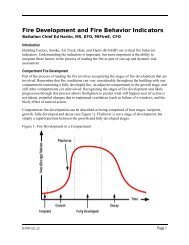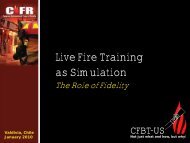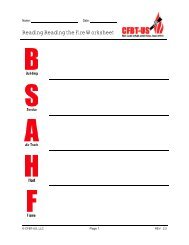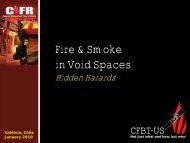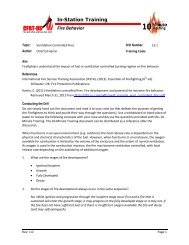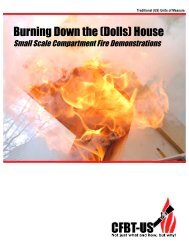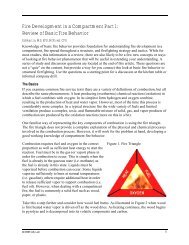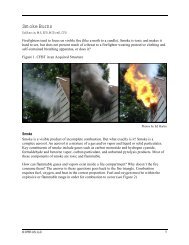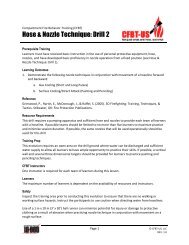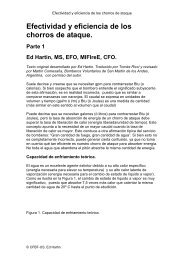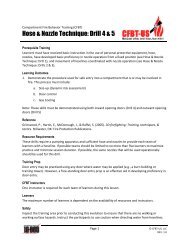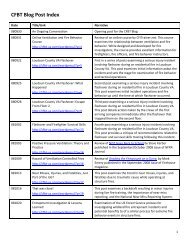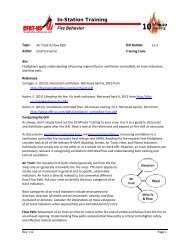CFBT INSTRUCTOR COURSE INFORMATION SHEET ... - CFBT-US!
CFBT INSTRUCTOR COURSE INFORMATION SHEET ... - CFBT-US!
CFBT INSTRUCTOR COURSE INFORMATION SHEET ... - CFBT-US!
You also want an ePaper? Increase the reach of your titles
YUMPU automatically turns print PDFs into web optimized ePapers that Google loves.
<strong>CFBT</strong> <strong>INSTRUCTOR</strong><br />
<strong>COURSE</strong> <strong>INFORMATION</strong> <strong>SHEET</strong><br />
Course Description<br />
The <strong>CFBT</strong> Instructor course provides participants with a sound understanding of fire behavior, fire<br />
development in a compartment, and fire control principles and practices. In addition, participants learn<br />
how to effectively deliver compartment fire behavior training in the classroom, using small scale props,<br />
and live fire training in purpose built structures (container based props and burn buildings).<br />
Target Audience<br />
<strong>CFBT</strong> Instructor is intended for firefighters and fire officers who will be responsible for the delivery of<br />
compartment fire behavior training (inclusive of classroom and live fire instruction).<br />
Prerequisites<br />
Participants attending the <strong>CFBT</strong> Instructor course must have completed <strong>CFBT</strong> Level I (or equivalent<br />
training). This prerequisite is particularly important as this course builds on the knowledge and skill as<br />
developed in <strong>CFBT</strong> Level I.<br />
Participants must be medically and physically qualified to wear self-contained breathing<br />
apparatus (SCBA). Occupational Safety and Health Administration (OSHA) Respiratory<br />
Protection regulations (29 Code of Federal Regulations (CFR) 1910. 134) require that<br />
individuals who wear self-contained breathing apparatus (SCBA) receive an annual medical<br />
evaluation and be fit tested for the breathing apparatus used. In addition, this regulation prohibits<br />
conditions that may interfere with facepiece seal (e.g., facial hair in the area of the facepiece<br />
seal).<br />
NFPA 1981 Standard on Open-Circuit SCBA for Emergency Services (2007) and NFPA 1500<br />
Standard on Fire Department Occupational Safety and Health Program (2007) provide additional<br />
information on the medical and physical qualification for the use of SCBA.<br />
Agencies selecting participants for <strong>CFBT</strong> Instructor training, should consider the following<br />
recommendations on minimum qualifications. While student selection is the responsibility of their<br />
individual department, it is highly recommended that participants have substantive firefighting and<br />
instructional experience<br />
Live fire training presents the same hazards as structural firefighting. The risk to participants<br />
must be managed through safe and effective training practices implemented by qualified<br />
instructors. Instructors who will deliver live fire training must be well trained and experienced<br />
firefighters or fire officers. In addition to technical competence, instructors must consistently<br />
demonstrate positive safety behaviors during both training and incident operations.<br />
Certification does not ensure competence. However, it provides externally validated<br />
documentation of essential training and assessment of knowledge and skills. Structural live fire<br />
© <strong>CFBT</strong>-<strong>US</strong>,LLC Page 1 REV: 2.0<br />
www.cfbt-us.com 10/12/08
<strong>CFBT</strong> <strong>INSTRUCTOR</strong> - <strong>COURSE</strong> <strong>INFORMATION</strong> <strong>SHEET</strong><br />
instructors should posses the minimum competencies identified by certification at the following<br />
levels:<br />
• Firefighter II<br />
• Fire Instructor I<br />
• Cardiopulmonary Resuscitation-Health Care Provider<br />
It is desirable that instructors be certified at the Emergency Medical Technician-Basic (EMT-B)<br />
level or above. If this is not the case, provisions must be made for availability of other medically<br />
trained personnel to evaluate participants’ medical condition during rehabilitation or in the event<br />
of illness or injury.<br />
<strong>CFBT</strong> instructors who will serve in the role of incident commander or safety officer during live<br />
fire training evolutions should also posses the minimum competencies identified by certification<br />
at the following levels:<br />
• Fire Officer I<br />
• Incident Safety Officer<br />
Experience is not based simply an individual’s years of service. Experience requires participation<br />
and learning, simply being there is not enough. While in many fire departments, opportunity to<br />
participate in structural firefighting operations is limited, this is an important factor. Limited<br />
experience during emergency incidents must be balanced by increased participation in training<br />
activities and in particular structural live fire training.<br />
• In fire departments that have a moderate to high level of fire activity, instructors should<br />
generally have at least four years as a firefighter before qualification as a live fire<br />
instructor.<br />
• In fire departments that have a low level of fire activity, instructors will require additional<br />
time to develop the necessary experience. The Department must consider this on a caseby-case<br />
basis.<br />
Class Size<br />
Due to the intensive hands on and interactive nature of this program, class size is limited to 12 students.<br />
Larger classes may be accommodated, but this requires use of additional instructors and logistical support<br />
to ensure participant safety and an effective learning environment.<br />
Credit/Certification<br />
This course is not designed to meet specific certification requirements (however the content of this course<br />
meets in part the requirements of NFPA 1001 Standard for Firefighter Professional Qualifications (5.3.10,<br />
5.3.11, 5.3.12, and 6.3.2) and assists the participants in performing instructional responsibilities outlined<br />
in NFPA 1403 Standard for Live Fire Training.<br />
Schedule<br />
The 40-hour <strong>CFBT</strong> Instructor course is generally delivered over five consecutive days. Course delivery<br />
integrates classroom instruction, case studies, small-scale lab demonstrations, multiple live fire training<br />
© <strong>CFBT</strong>-<strong>US</strong>,LLC Page 2 REV: 2.0<br />
www.cfbt-us.com 10/12/08
<strong>CFBT</strong> <strong>INSTRUCTOR</strong> - <strong>COURSE</strong> <strong>INFORMATION</strong> <strong>SHEET</strong><br />
sessions, and participant presentations to further develop the participants knowledge of fire behavior and<br />
instructional skill in both the classroom and hands-on, live fire, environments.<br />
Day 1<br />
• Introduction<br />
• Fire Behavior Demonstration 2 (Live Fire)<br />
• Teaching Fundamentals of Fire Behavior<br />
• Teaching Fire Development in a<br />
Compartment<br />
• Teaching About Extreme Fire Behavior<br />
• Burning Down the Dolls House<br />
• Introduction to Crew Resource<br />
Management (CRM)<br />
Day 2<br />
• Pre-training medical monitoring<br />
• Extreme Fire Behavior Demonstration 1<br />
(Live Fire)<br />
• Teaching Fire Control and Door Entry<br />
• Nozzle Technique and Hose Handling<br />
• Individual Case Study Presentations<br />
• Leadership and CRM<br />
• Fire Attack 1 (Live Fire)<br />
Learning Outcomes<br />
Day 3<br />
• Pre-training medical monitoring<br />
• Fire Attack 2 or 3 (Live Fire)<br />
• Nozzle Technique and Hose Handling<br />
• Influence of Ventilation on Fire Behavior<br />
• Regulations and Standards<br />
• Fire Attack 3 (Live Fire)<br />
Day 4<br />
• Team Case Study Presentations<br />
• <strong>CFBT</strong> in Acquired Structures<br />
• <strong>CFBT</strong> in Purpose Build Burn Buildings and<br />
Multi-Compartment Cells<br />
• Tactical Exercises<br />
Day 5<br />
• Review<br />
• Exam<br />
• Participant Classroom Presentations<br />
Critical learning outcomes include a sound understanding of practical fire dynamics and the ability to<br />
provide safe and effective compartment fire behavior training. Specific learning outcomes are as follows:<br />
Introduction (Classroom)<br />
Participants understand the hazard presented by potential for extreme fire behavior and the need for safe<br />
and effective compartment fire behavior training.<br />
• Recognize national trends in the frequency of structure fires.<br />
• Recognize national trends in firefighter injuries and fatalities due to trauma during interior<br />
firefighting operations.<br />
• Identify potential causal factors influencing rate of injury and death due to trauma during interior<br />
firefighting operations.<br />
• Recognize the limitations in current injury and fatality reporting systems with regards to<br />
identifying fatalities, injuries, and near miss events involving extreme fire behavior.<br />
• Understand the underlying concept of compartment fire behavior training (<strong>CFBT</strong>).<br />
• Identify the instructor’s role and responsibilities in ensuring participant safety during <strong>CFBT</strong>.<br />
© <strong>CFBT</strong>-<strong>US</strong>,LLC Page 3 REV: 2.0<br />
www.cfbt-us.com 10/12/08
<strong>CFBT</strong> <strong>INSTRUCTOR</strong> - <strong>COURSE</strong> <strong>INFORMATION</strong> <strong>SHEET</strong><br />
Fire Behavior Demonstration 2 (Live Fire)<br />
Participants to understand how to conduct Fire Behavior Demonstration 1 as used in <strong>CFBT</strong> Level I.<br />
Developing competence in conducting this demonstration will require coached practice.<br />
• Understand the <strong>CFBT</strong>-<strong>US</strong> standard operating guidelines applicable to conducting Fire Behavior<br />
Demonstration 1 and 2.<br />
• Identify the potential problems that might occur while conducting Fire Behavior Demonstration 1<br />
and 2 as well as the appropriate methods for resolving these problems.<br />
• Identify the procedure used to inspect the demo/attack cell prior to use.<br />
• Understand the rationale and procedure for conducting a field inspection of participant personal<br />
protective equipment prior to live fire training.<br />
• Recognize the required elements of a pre-training safety and instructional briefing and walk<br />
through of the prop used for live fire training.<br />
• Describe the key observations made by participants during Fire Behavior Demonstration 1 and 2.<br />
• Demonstrate basic skill in gas and surface cooling under live fire conditions.<br />
• Explain how the instructor maintains appropriate fire conditions for the duration of Fire Behavior<br />
Demonstration 1and 2.<br />
• Describe the advantages and disadvantages of verbal and non-verbal instructional styles for<br />
conducting Fire Behavior Demonstration 1 and 2.<br />
• Explain the post-training debriefing process with particular emphasis on the use of questions to<br />
enhance participant learning.<br />
Teaching Fundamentals of Fire Behavior (Classroom)<br />
Participants have the knowledge required to deliver the Fundamentals of Fire Behavior module included<br />
in the <strong>CFBT</strong> Level I curriculum.<br />
• Identify individual knowledge gaps in the fundamentals of fire behavior presented in <strong>CFBT</strong> Level<br />
I.<br />
• Recognize common misconceptions related to the concepts of energy, heat, and temperature.<br />
• Explain basic concepts of thermal dynamics, including: thermal energy, temperature, and<br />
methods of heat transfer.<br />
• Recognize the utility and limitations of the fire triangle and fire tetrahedron as models of<br />
combustion.<br />
• Explain the concepts of pyrolysis, specific heat, latent heat of vaporization, heat of combustion,<br />
and heat release rate.<br />
• Demonstrate laboratory exercises and use of manipulatives used to illustrate fundamental fire<br />
behavior concepts.<br />
• Identify audiovisual and web resources for teaching about compartment fire development.<br />
© <strong>CFBT</strong>-<strong>US</strong>,LLC Page 4 REV: 2.0<br />
www.cfbt-us.com 10/12/08
<strong>CFBT</strong> <strong>INSTRUCTOR</strong> - <strong>COURSE</strong> <strong>INFORMATION</strong> <strong>SHEET</strong><br />
Teaching Fire Development in a Compartment (Classroom)<br />
Participants have the knowledge required to deliver the Fire Development in a Compartment module<br />
included in the <strong>CFBT</strong> Level I curriculum.<br />
• Explain how changes in the built environment (e.g., increased use of synthetics, light weight<br />
construction, and energy efficiency) influence compartment fire behavior.<br />
• Use a basic heat release rate curve to explain the stages of compartment fire development and<br />
controlled burning regimes (fuel and ventilation controlled).<br />
• Demonstrate the use of manipulatives to illustrate heat release rate during fire development,<br />
influence of limited ventilation, and transfer of potential energy from solid to gas phase fuel due<br />
to pyrolysis.<br />
• Demonstrate appropriate use of fire dynamics terminology (e.g., plume, ceiling jet, ceiling (hot<br />
gas) layer, neutral plane, air track, gravity current) in describing fire development in a<br />
compartment.<br />
• Using the oxygen consumption principle (Thornton’s Rule), explain changes in fire behavior<br />
related to burning regime and changes in ventilation profile.<br />
• Describe how Building, Smoke, Air Track, Heat, and Flame (B-SAHF) indicators relate to fire<br />
development and burning regime.<br />
• Identify audiovisual and web resources for teaching about compartment fire development.<br />
Teaching About Extreme Fire Behavior (Classroom)<br />
Participants have the knowledge required to deliver the Extreme Fire Behavior module included in the<br />
<strong>CFBT</strong> Level I curriculum.<br />
• Explain the following extreme fire behavior phenomena with an emphasis on conditions required<br />
for them to occur and initiating factors: Flashover, backdraft, smoke explosion, and flash fire.<br />
• Demonstrate the use of manipulatives to illustrate how extreme fire behavior phenomena occur.<br />
• Analyze a case study involving extreme fire behavior and identify causal factors and how the<br />
firefighters involved could have prevented, trapped, or mitigated errors that lead to their near<br />
miss, injury, or fatality.<br />
• Use the graphical output (Smokeview) from a computational fluid dynamics model (Fire<br />
Dynamics Simulator) to explain fire development and extreme fire behavior conditions.<br />
• Describe how Building, Smoke, Air Track, Heat, and Flame (B-SAHF) indicators relate to<br />
extreme fire behavior phenomenon.<br />
• Identify audiovisual and web resources for teaching about extreme fire behavior.<br />
Burning Down the (Doll’s) House (Laboratory Exercise)<br />
Participants have the knowledge and skills required to deliver the Burning Down the Doll’s House<br />
module included in the <strong>CFBT</strong> Level I curriculum.<br />
• Identify the rationale, advantages, and disadvantages of using small scale props for teaching<br />
about fire development and extreme fire behavior.<br />
© <strong>CFBT</strong>-<strong>US</strong>,LLC Page 5 REV: 2.0<br />
www.cfbt-us.com 10/12/08
<strong>CFBT</strong> <strong>INSTRUCTOR</strong> - <strong>COURSE</strong> <strong>INFORMATION</strong> <strong>SHEET</strong><br />
• Understand the <strong>CFBT</strong>-<strong>US</strong> standard operating guidelines applicable to use of small scale props for<br />
fire behavior demonstrations.<br />
• Recognize the required elements of a pre-training safety and instructional briefing prior to<br />
conducting demonstrations using a doll’s house.<br />
• Describe the key observations made by participants during the single compartment doll’s house<br />
demonstration.<br />
• Identify the application of the following small scale props: Single compartment doll’s house, twocompartment<br />
dolls house, four-compartment dolls house, and vent wall.<br />
Introduction to Crew Resource Management (Classroom)<br />
Participants recognize the applicability of Crew Resource Management principles to the fire service in<br />
general and to <strong>CFBT</strong> in particular.<br />
• Identify how the concept of risk homeostasis applies to the fire service.<br />
• Determine an appropriate risk management profile for <strong>CFBT</strong>.<br />
• Explain the integration of Helmreich’s error management model with the concepts presented in<br />
<strong>CFBT</strong>.<br />
• Describe the concept and basic principles of CRM.<br />
• Explain how effective communication can increase safety during <strong>CFBT</strong> and on the fireground.<br />
• Identify the how inquiry, advocacy, and assertive behavior can be applied to increase safety<br />
during <strong>CFBT</strong> and on the fireground.<br />
Extreme Fire Behavior Demonstration 1 (Live Fire)<br />
Participants recognize how full-scale demonstrations enhance understanding of fire development, extreme<br />
fire behavior, and fire behavior indicators. Participants also understand how to conduct Extreme Fire<br />
Behavior Demonstration 1. Developing competence in conducting this demonstration will require<br />
coached practice.<br />
• Understand the <strong>CFBT</strong>-<strong>US</strong> standard operating guidelines applicable to conducting Extreme Fire<br />
Behavior Demonstration 1.<br />
• Identify the potential problems that might occur while conducting Extreme Fire Behavior<br />
Demonstration 1and the appropriate methods for resolving these problems.<br />
• Identify the procedure used to inspect the window cell prior to use.<br />
• Recognize the required elements of a pre-training safety and instructional briefing and walk<br />
through of the prop used for live fire training.<br />
• Describe the key observations made by participants during Extreme Fire Behavior Demonstration<br />
1.<br />
• Explain the post-training debriefing process with particular emphasis on the use of questions to<br />
enhance participant learning.<br />
© <strong>CFBT</strong>-<strong>US</strong>,LLC Page 6 REV: 2.0<br />
www.cfbt-us.com 10/12/08
<strong>CFBT</strong> <strong>INSTRUCTOR</strong> - <strong>COURSE</strong> <strong>INFORMATION</strong> <strong>SHEET</strong><br />
Teaching Fire Control and Door Entry (Classroom)<br />
Participants have the knowledge required to deliver the Fire Control and Door Entry module included in<br />
the <strong>CFBT</strong> Level I curriculum.<br />
• Use the heating curve for water to explain the theoretical cooling capacity of water.<br />
• Explain the relationship between heat release rate (fire power) and flow rate (firefighting power).<br />
• Describe and identify the capabilities and limitations of common methods of estimating required<br />
flow rate for fire control (Iowa, National Fire Academy, and Hartin or Grimwood Tactical Rate of<br />
Flow).<br />
• Explain the influence of where water is converted to steam (hot gas layer or surfaces) on fire<br />
control effectiveness and compartment tenability.<br />
• Describe the application of 3D gas cooling, direct, and indirect attack.<br />
• Describe the sequence and purpose of the door entry procedure.<br />
• Explain the concept of dynamic risk assessment and its relationship to size-up and situational<br />
awareness.<br />
• Respond to frequently asked questions related to fire control methods and door entry procedures.<br />
Nozzle Technique and Hose Handling (Hands-On)<br />
Participants have the knowledge and skill in door entry procedures, nozzle techniques, and hose handling<br />
to deliver the Nozzle Techniques and Hose Handling module in <strong>CFBT</strong> Level I.<br />
• Demonstrate proficiency in the door entry procedure.<br />
• Demonstrate proficiency in use of short and long pulses, painting, and penciling.<br />
• Demonstrate proficiency in gas cooling while advancing and retreating with a small (e.g. 1 ¾”<br />
(45 mm)) hoseline.<br />
• Coach other participants in performance of nozzle techniques and door entry procedures.<br />
Individual Case Study Presentations (Out-of-Class & Classroom)<br />
Participants recognize the hazards presented by live fire training and the steps necessary to mitigate or<br />
reduce the risks involved.<br />
Analyze a case study involving a live fire training line-of-duty death (LODD) to determine causal<br />
factors and identify appropriate risk management action steps.<br />
Leadership and Crew Resource Management (Classroom)<br />
Participants recognize their role as leaders and the centrality of leadership relationships to CRM during<br />
<strong>CFBT</strong> and on the fireground.<br />
• Explain the concept that teaching is leading.<br />
• Describe the difference between a leader/follower relationship and individuals participating in a<br />
leadership relationship.<br />
• Recognize how instructors and participants interact in a leadership relationship during <strong>CFBT</strong>.<br />
© <strong>CFBT</strong>-<strong>US</strong>,LLC Page 7 REV: 2.0<br />
www.cfbt-us.com 10/12/08
<strong>CFBT</strong> <strong>INSTRUCTOR</strong> - <strong>COURSE</strong> <strong>INFORMATION</strong> <strong>SHEET</strong><br />
• Identify common errors that impact on safety during <strong>CFBT</strong>.<br />
• Explain how to maximize situational awareness on the part of all participants during <strong>CFBT</strong>.<br />
• Describe the potential impact of CRM on your practice as a <strong>CFBT</strong> Instructor and on your<br />
organization.<br />
Fire Attack 1 (Live Fire)<br />
Participants understand how to conduct the Fire Attack 1evolution. Developing competence in conducting<br />
this evolution will require coached practice.<br />
• Understand the <strong>CFBT</strong>-<strong>US</strong> standard operating guidelines applicable to conducting Fire Attack 1.<br />
• Identify the potential problems that might occur while conducting Fire Attack 1 and the<br />
appropriate methods for resolving these problems.<br />
• Identify the procedure used to inspect the demo/attack cell prior to use.<br />
• Recognize the required elements of a pre-training safety and instructional briefing and walk<br />
through of the prop used for live fire training.<br />
• Describe the participant learning outcomes for Fire Attack 1.<br />
• Explain how the instructor maintains appropriate fire conditions for the duration of Fire Attack 1.<br />
• Demonstrate proficiency in gas and surface cooling techniques under live fire conditions.<br />
• Describe the advantages and disadvantages of verbal and non-verbal instructional styles for<br />
conducting Fire Attack 1.<br />
• Explain the post-training debriefing process with particular emphasis on the use of questions to<br />
enhance participant learning.<br />
Fire Attack 2 (Live Fire)<br />
Participants understand how to conduct the Fire Attack 2 evolution. Developing competence in<br />
conducting this evolution will require coached practice.<br />
• Understand the <strong>CFBT</strong>-<strong>US</strong> standard operating guidelines applicable to conducting Fire Attack 2.<br />
• Identify the potential problems that might occur while conducting Fire Attack 2 and the<br />
appropriate methods for resolving these problems.<br />
• Identify the procedure used to inspect the demo/attack cell prior to use.<br />
• Recognize the required elements of a pre-training safety and instructional briefing and walk<br />
through of the prop used for live fire training.<br />
• Describe the participant learning outcomes for Fire Attack 1.<br />
• Explain how the instructor maintains appropriate fire conditions for the duration of Fire Attack 2.<br />
• Demonstrate proficiency in gas cooling while advancing and retreating and surface cooling<br />
techniques under live fire conditions.<br />
• Describe the advantages and disadvantages of verbal and non-verbal instructional styles for<br />
conducting Fire Attack 2.<br />
© <strong>CFBT</strong>-<strong>US</strong>,LLC Page 8 REV: 2.0<br />
www.cfbt-us.com 10/12/08
<strong>CFBT</strong> <strong>INSTRUCTOR</strong> - <strong>COURSE</strong> <strong>INFORMATION</strong> <strong>SHEET</strong><br />
• Explain the post-training debriefing process with particular emphasis on the use of questions to<br />
enhance participant learning.<br />
Door Entry and Nozzle Technique Drill (Hands-On)<br />
Participants have the knowledge and skill in door entry procedures, nozzle techniques, and hose handling<br />
to deliver the Nozzle Techniques and Hose Handling module in <strong>CFBT</strong> Level I.<br />
• Identify the advantages of using a door entry prop to develop proficiency.<br />
• Explain the concept of deliberate practice and how this applies to developing proficiency in<br />
nozzle technique and door entry procedures.<br />
• Demonstrate proficiency in the door entry procedure.<br />
• Demonstrate proficiency in use of short and long pulses, painting, and penciling.<br />
• Demonstrate proficiency in gas cooling while advancing and retreating with a small (e.g. 1 ¾”<br />
(45 mm)) hoseline.<br />
• Demonstrate coaching learners in nozzle techniques and door entry procedures.<br />
Influence of Ventilation on Fire Behavior (Classroom)<br />
Participants understand the influence of ventilation on fire development and extreme fire behavior and<br />
have the knowledge to deliver the Extreme Fire Behavior module in <strong>CFBT</strong> Level I.<br />
• Identify common misconceptions related to ventilation strategies and tactics.<br />
• Explain the apparently conflicting influences of ventilation on ventilation controlled fires:<br />
Removal of thermal energy (e.g., hot smoke) and increased heat release rate.<br />
• Describe and provide examples of ventilation, unplanned ventilation, tactical ventilation, and<br />
tactical anti-ventilation.<br />
• Explain the concept of tactical anti-ventilation and how this relates to the traditional concept of<br />
confinement.<br />
• Understand the influence of horizontal and vertical ventilation on fire behavior and the fire<br />
environment.<br />
Live Fire Training Regulations & Standards (Classroom)<br />
Participants understand and can conduct live fire training consistent with the requirements of applicable<br />
regulations and standards.<br />
• Identify applicable occupational safety and health regulations that are applicable to live fire<br />
training.<br />
• Identify national consensus standards that are applicable to live fire training.<br />
• Describe how NFPA 1403 defines live fire training.<br />
• Explain the general provisions of NFPA 1403 that are applicable to <strong>CFBT</strong> in purpose built props<br />
and burn buildings.<br />
• Identify the responsibilities of the authority having jurisdiction (AHJ) with regards to instructor<br />
qualification.<br />
© <strong>CFBT</strong>-<strong>US</strong>,LLC Page 9 REV: 2.0<br />
www.cfbt-us.com 10/12/08
<strong>CFBT</strong> <strong>INSTRUCTOR</strong> - <strong>COURSE</strong> <strong>INFORMATION</strong> <strong>SHEET</strong><br />
• Identify the responsibilities of the instructor-in-charge when conducting live fire training in a<br />
purpose built prop or burn building.<br />
Fire Attack 3 (Live Fire)<br />
Participants understand how to conduct the Fire Attack 3 evolution. Developing competence in<br />
conducting this evolution will require coached practice.<br />
• Understand the <strong>CFBT</strong>-<strong>US</strong> standard operating guidelines applicable to conducting Fire Attack 3.<br />
• Identify the potential problems that might occur while conducting Fire Attack 3 and the<br />
appropriate methods for resolving these problems.<br />
• Identify the procedure used to inspect the demo/attack cell prior to use.<br />
• Recognize the required elements of a pre-training safety and instructional briefing and walk<br />
through of the prop used for live fire training.<br />
• Describe the participant learning outcomes for Fire Attack 3.<br />
• Explain how the instructor maintains appropriate fire conditions for the duration of Fire Attack 3.<br />
• Demonstrate proficiency in door entry procedures under live fire conditions.<br />
• Demonstrate proficiency in gas cooling while advancing and retreating and surface cooling<br />
techniques under live fire conditions.<br />
• Describe the advantages and disadvantages of verbal and non-verbal instructional styles for<br />
conducting Fire Attack 3.<br />
• Explain the post-training debriefing process with particular emphasis on the use of questions to<br />
enhance participant learning.<br />
Team Case Study Presentations (Out-of-Class & Classroom)<br />
Participants recognize the hazards presented by live fire training and the steps necessary to mitigate or<br />
reduce the risks involved.<br />
• Analyze a live fire training LODD case study with regards to compliance with applicable<br />
regulations and standards.<br />
• Identify the influence of the level of fire behavior knowledge of the participants on situational<br />
awareness and decision-making.<br />
• Analyze a case study involving a live fire training line-of-duty death (LODD) to determine causal<br />
factors and identify appropriate risk management action steps.<br />
<strong>CFBT</strong> & Acquired Structures (Classroom)<br />
Participants understand the hazards presented, regulatory and standards requirements, and risk<br />
management strategies used when conducting live fire training in acquired structures.<br />
Note: This course does not substantively address live fire training in acquired structures. However, it is<br />
incumbent on <strong>CFBT</strong> instructors to have an understanding of this type of training.<br />
• Explain the general provisions of NFPA 1403 that are applicable to <strong>CFBT</strong> in acquires structures<br />
and how they differ from those applicable to training in purpose built props and burn buildings.<br />
© <strong>CFBT</strong>-<strong>US</strong>,LLC Page 10 REV: 2.0<br />
www.cfbt-us.com 10/12/08
<strong>CFBT</strong> <strong>INSTRUCTOR</strong> - <strong>COURSE</strong> <strong>INFORMATION</strong> <strong>SHEET</strong><br />
• Identify the responsibilities of the instructor-in-charge when conducting live fire training in a<br />
purpose built prop or burn building.<br />
• Describe how to evaluate a compartment and fuel load to develop a fire behavior prediction.<br />
• Recognize the documentation required when conducting live fire training in an acquired structure.<br />
<strong>CFBT</strong> in Purpose Built Burn Buildings (Classroom)<br />
Participants can effectively apply <strong>CFBT</strong> concepts when conducting live fire training in purpose built burn<br />
buildings and multi-compartment container based props.<br />
• Identify the performance differences between single compartment container based props and<br />
purpose built burn buildings and multi-compartment container based props.<br />
• Explain how to apply <strong>CFBT</strong> concepts when conducting live fire training in a multi-compartment<br />
environment.<br />
Tactical Exercises (Live Fire)<br />
Participants understand how to conduct <strong>CFBT</strong> tactical exercises. Developing competence in delivery of<br />
this type of training will require coached practice.<br />
• Understand the <strong>CFBT</strong>-<strong>US</strong> standard operating guidelines applicable to conducting tactical<br />
exercises.<br />
• Identify the potential problems that might occur while conducting tactical exercises and the<br />
appropriate methods for resolving these problems.<br />
• Identify the procedure used to inspect the cell or purpose built burn building prior to use.<br />
• Recognize the required elements of a pre-training safety and instructional briefing and walk<br />
through of the prop used for live fire training.<br />
• Describe the participant learning outcomes for tactical exercises.<br />
• Explain how the instructor maintains appropriate fire conditions for the duration of tactical<br />
exercises.<br />
• Demonstrate proficiency in door entry procedures under live fire conditions.<br />
• Demonstrate proficiency in gas cooling while advancing and retreating and surface cooling<br />
techniques under live fire conditions.<br />
• Explain the post-training debriefing process with particular emphasis on the use of questions to<br />
enhance participant learning.<br />
Participant Student Teaching (Classroom)<br />
Participants demonstrate competence in delivery of compartment fire behavior classroom instruction.<br />
Course Text/Reader<br />
The course text is 3D Firefighting: Training, Techniques, & Tactics written by Paul Grimwood, Ed<br />
Hartin, John McDonough, & Shan Raffel. Each participant will receive an individual copy of the course<br />
text. In addition to the course text, there are numerous readings and case studies in the <strong>CFBT</strong> Instructor<br />
Course Reader (provided to the client in PDF format). Participants will also require access to National<br />
Fire Protection Association (NFPA) 1403 Standard on Live Fire Training (2007). Participants will also<br />
© <strong>CFBT</strong>-<strong>US</strong>,LLC Page 11 REV: 2.0<br />
www.cfbt-us.com 10/12/08
<strong>CFBT</strong> <strong>INSTRUCTOR</strong> - <strong>COURSE</strong> <strong>INFORMATION</strong> <strong>SHEET</strong><br />
receive an extensive bibliography of reference materials that are useful in developing a deeper<br />
understanding of fire behavior, fire dynamics, firefighting tactical operations and compartment fire<br />
behavior training.<br />
Learning Activities, Assignments, & Assessment<br />
The <strong>CFBT</strong> Instructor course incorporates a wide range of individual and team learning activities including<br />
classroom discussion, case studies, and demonstrations as well as hands-on application and live fire<br />
exercises.<br />
Participants’ knowledge and skills will be assessed through completion of case study presentations,<br />
written quizzes, practical exercises, and a written final examination. Successful completion of the<br />
instructor course requires participants to demonstrate acceptable performance of skills and a cumulative<br />
score of 120 points on quizzes (25 points each) and the final examination (50 points).<br />
Case Study Presentation 1<br />
Each participant will analyze and deliver an informal presentation of a case study (case materials<br />
provided) involving a line-of-duty death occurring during live fire training.<br />
Case Study Presentation 2<br />
Teams of participants will analyze and deliver an informal presentation based on a case study involving a<br />
live fire training fatality in an acquired structure.<br />
Manipulative Skills<br />
Instructor trainers will evaluate and provide feedback on participant performance during live fire and<br />
other hands-on training activities.<br />
Daily Quizzes<br />
Participants will be provided with a quiz at the end of training days one though four. Daily quizzes may<br />
be completed outside of class, but additional time is provided at the start of the next training day to<br />
complete this assignment. Daily quizzes use predominantly short answer and essay questions to assist<br />
participants in mastering course content. Each of the four quizzes has a value of 25 points. Questions in<br />
the daily quizzes focus on key concepts and how the participant would answer learner questions. For<br />
example, a student is confused about the difference between flashover and backdraft. How would you<br />
explain this?<br />
Written Final Examination<br />
The final examination is administered on the morning of the last day of the course and is comprised of<br />
short answer and essay questions. The final examination has a value of 50 points. Similar to the daily<br />
quizzes, the the final examination focuses on understanding of key concepts and how the participant<br />
would answer learner questions.<br />
Task Book<br />
Participants will be provided with a task book following successful completion of training that may be<br />
used to document supervised field experience in delivery of compartment fire behavior training. This<br />
element of assessment may be used by the participant’s agency at their discretion.<br />
© <strong>CFBT</strong>-<strong>US</strong>,LLC Page 12 REV: 2.0<br />
www.cfbt-us.com 10/12/08
Facilities & Logistics<br />
<strong>CFBT</strong> <strong>INSTRUCTOR</strong> - <strong>COURSE</strong> <strong>INFORMATION</strong> <strong>SHEET</strong><br />
There are a number of facility and logistical requirements necessary for effective delivery of the <strong>CFBT</strong><br />
Instructor course. These include:<br />
Classroom<br />
Required classroom facilities include a white board, projection screen, data projector, and seating at tables<br />
for the number of learners who will be participating in the class.<br />
Live Fire Facilities<br />
The <strong>CFBT</strong> Instructor course can be conducted using a variety of container based props and purpose built<br />
burn buildings. Ideally several different facilities should be available to demonstrate the applicability of<br />
the methods and techniques in various contexts.<br />
Logistical Support<br />
Logistical requirements include the following:<br />
• Duplication of Student Manuals (PDF file provided)<br />
• SCBA for each participant (including <strong>CFBT</strong>-<strong>US</strong> Instructors)<br />
• Students must have personal protective euqipment as outlined in NFPA 1403.<br />
• Cascade system or breathing air compressor for cylinder refill<br />
• Drinking water for participant rehab<br />
• Two fire apparatus capable of supplying multiple hoselines flowing 125 gpm<br />
• Water supply to support hands-on training (continuous supply or 3000 gallons on-site)<br />
• Dolls houses for fire development lab exercise (these simple props are constructed from<br />
¾” (16 mm) particle board (plans provided)<br />
• Access to Emergency Medical Services (EMS)<br />
• Fuel for live fire evolutions (approximately 16 sheets of ½” (12 mm) particleboard<br />
depending on the specific prop or live fire training facilities used).<br />
During the initial live fire training evolution, the fuel requirements for the specific props used for<br />
the course will be evaluated and adjusted. <strong>CFBT</strong>-<strong>US</strong> policy is to use the minimum amount of<br />
fuel that will meet specified training objectives (this minimizes risk to participants and waste of<br />
fuel materials). Fuel used during <strong>CFBT</strong> must meet the requirements outlined in NFPA 1403.<br />
Standard ½” (12 mm) particle board serves as a safe and effective fuel for compartment fire<br />
behavior training evolutions. This fuel provides predictable fire development and sufficient burn<br />
duration to conduct instructional activities. The evolutions conducted during this course typically<br />
require no more than 8 sheets of ½” (12 mm) particle board depending on container<br />
configuration. Use of varied types of fuel such as plywood, oriented strand board (OSB) results<br />
in a much higher heat release rate and shorter duration of burn. Pallets are an extremely variable<br />
fuel (type of wood, configuration, etc.), but are used on a case by case basis in advanced <strong>CFBT</strong><br />
and <strong>CFBT</strong> Instructor training.<br />
© <strong>CFBT</strong>-<strong>US</strong>,LLC Page 13 REV: 2.0<br />
www.cfbt-us.com 10/12/08
Instructor Trainers<br />
<strong>CFBT</strong> <strong>INSTRUCTOR</strong> - <strong>COURSE</strong> <strong>INFORMATION</strong> <strong>SHEET</strong><br />
A minimum of two <strong>CFBT</strong> Instructor Trainers are required for delivery of the <strong>CFBT</strong> Instructor<br />
course (additional instructors may be needed depending on class size).<br />
All <strong>CFBT</strong>-<strong>US</strong> instructor trainers are experienced firefighters and fire officers who have<br />
completed <strong>CFBT</strong> Instructor program and have substantive experience in applying the knowledge<br />
and skills presented in this training program in an operational firefighting environment and in<br />
delivery of <strong>CFBT</strong> to diverse fire service audiences. Lead instructor trainers have demonstrated<br />
competence in training and evaluation of instructors as well as <strong>CFBT</strong> program development and<br />
implementation.<br />
Training Philosophy<br />
<strong>CFBT</strong>-<strong>US</strong> believes that learning is more than simply being present and receiving information.<br />
Participants are expected to actively engage in class activities and develop an expanded and deeper<br />
understanding of course concepts and basic proficiency in hands-on skills. Classes provide both<br />
classroom based and hands-on demonstrations and application activities to provide learners with a variety<br />
of ways to develop skill and understanding.<br />
Participants are encouraged to share their experience and be active participants during class sessions. It is<br />
likely that information will be presented (either by the instructors or fellow learners) that will challenge<br />
participants current views about fire behavior or firefighting methods. Please keep an open mind and<br />
evaluate the ideas presented on the basis of both scientific principles and your experience as a firefighter.<br />
Course Policies<br />
Members are encouraged to share their experience and be active participants during class sessions. It is<br />
likely that information will be presented (either by the instructors or fellow learners) that will challenge<br />
participants current views about fire behavior or firefighting methods. Please keep an open mind and<br />
evaluate the ideas presented on the basis of both scientific principles and your experience as a firefighter.<br />
The <strong>CFBT</strong> Instructor course includes out-of-class reading and preparation for case and instructional<br />
presentations. Completion of these assignments is not optional in that participant engagement in course<br />
learning activities is an integral part of class activity and development of baseline proficiency as a <strong>CFBT</strong><br />
Instructor.<br />
Participants have met the prerequisite training requirements outlined in NFPA 1403 and be medically and<br />
physically qualified to wear self-contained breathing apparatus (SCBA). In addition, all participants<br />
engaged in live fire training evolutions must be equipped with personal protective equipment as outlined<br />
in NFPA 1403.<br />
Additional Information<br />
For additional information on the <strong>CFBT</strong> Level I course or to request a quotation or proposal for delivery<br />
at your training facility, visit our web site or contact <strong>CFBT</strong>-<strong>US</strong> Chief Instructor Ed Hartin, MS, EFO,<br />
MIFireE, CFO.<br />
Web Site: www.cfbt-us.com<br />
Telephone: (503) 793-1296<br />
E-Mail: ed.hartin@cfbt-us.com<br />
© <strong>CFBT</strong>-<strong>US</strong>,LLC Page 14 REV: 2.0<br />
www.cfbt-us.com 10/12/08




